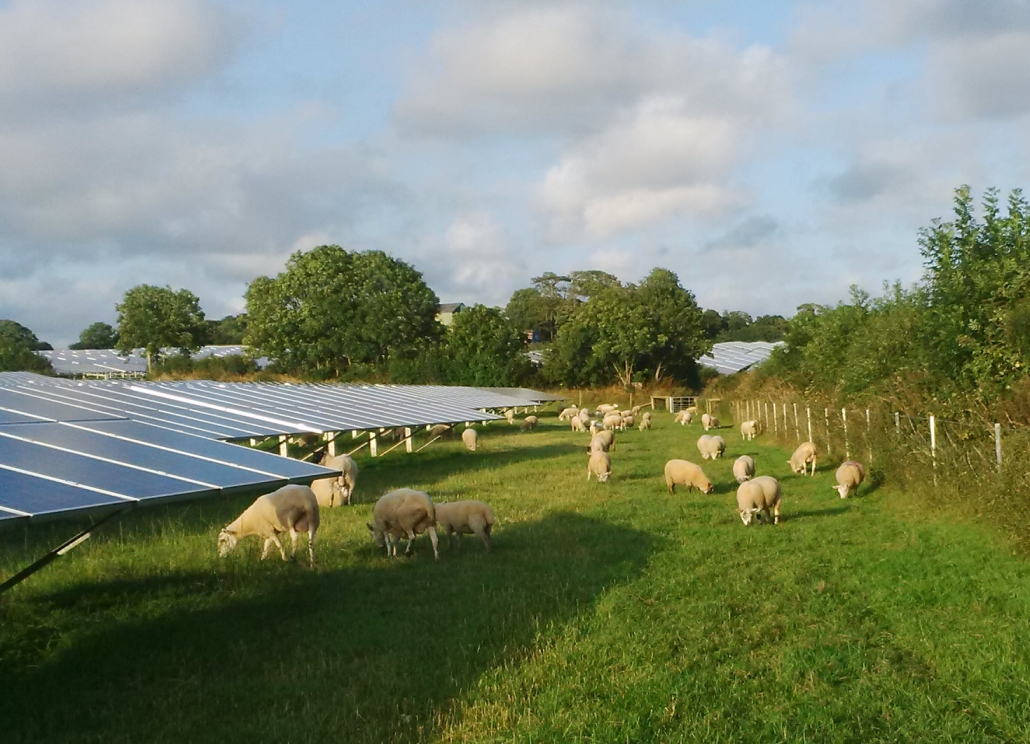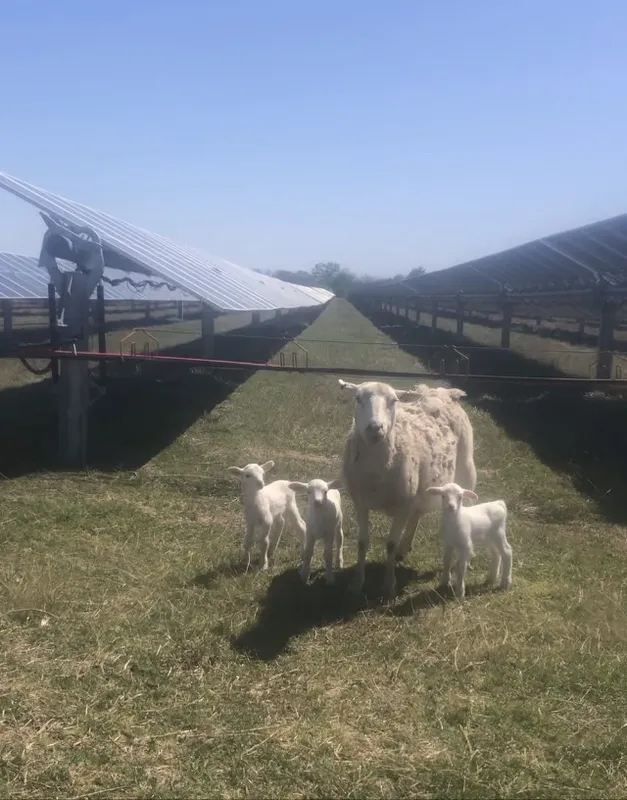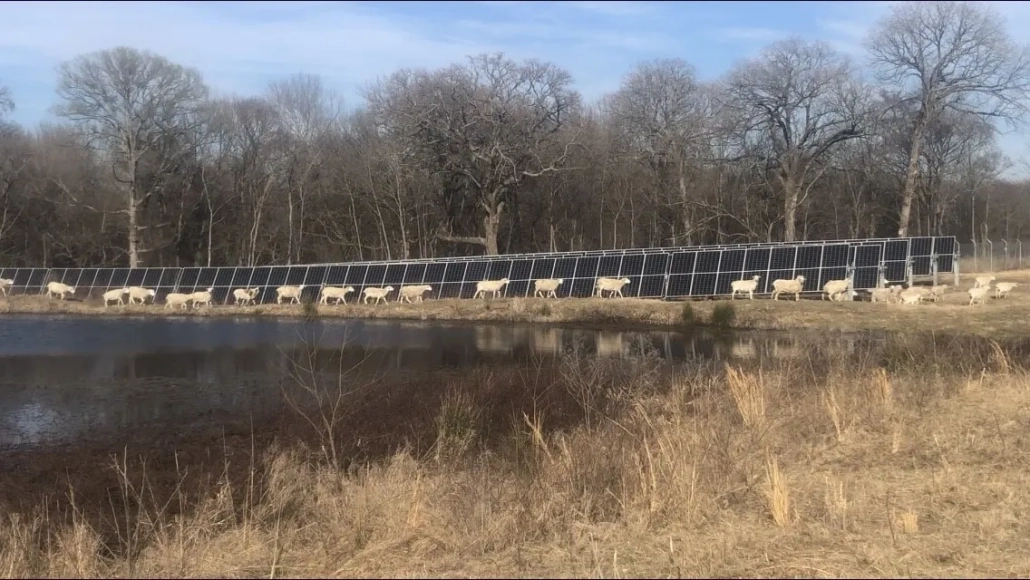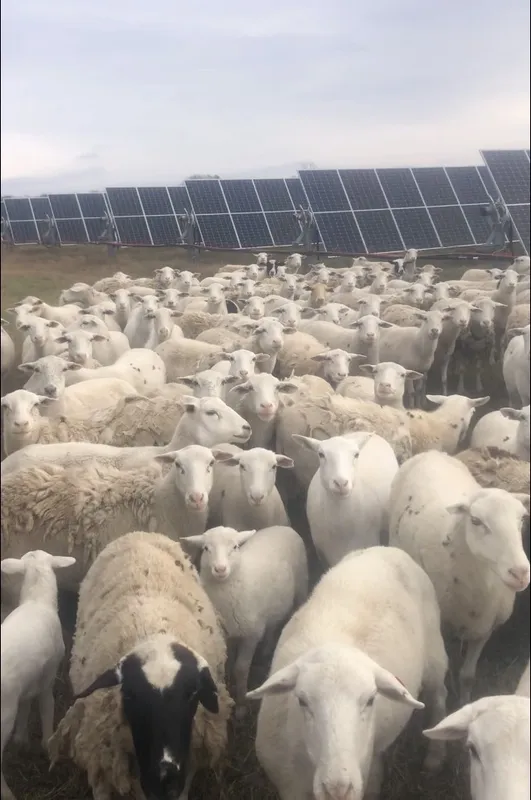The researchers in this study aimed to simulate crop yields for paddy rice, barley, and soybeans grown under photovoltaic panels with an eye on reaching suitable agricultural productivity for the energy and food nexus coexistence. They also applied a geospatial crop simulation modeling system to stimulate the regional variations in crop yield according to solar radiation reduction scenarios.
Tag Archive for: Agrivoltaics
This study evaluates green bean cultivation inside greenhouses with photovoltaic (PV) panels on the roof. Researchers found that the beans adapted to the change in shading by relocating more resources to the stems and leaves. As a result, average yield decreased compared to that of a conventional greenhouse. However, an economic trade-off between energy and crop yield can be achieved with a panel coverage of 10%. The research also provides an experimental framework that could be replicated and used as a decision support tool to identify other crops suitable for solar greenhouse cultivation.
Farmers in France are Beginning to Combine Solar Panels and Crops
“In the Haute-Saône region, in the northeastern part of the country, an experiment is being conducted by solar-energy company TSE. It is hoping to find out whether solar energy can be generated without hindering large-scale cereal crops. Previous attempts to experiment with agrivoltaics have been through smaller-scale projects. But, keen to see if it can thrive on an industrial level, 5,500 solar panels are being spread over this farm in the commune town of Amance by TSE.” – Euronews
Solar Grazing Event Helps Kentucky Students Learn about Agrisolar
“The event was made possible through a partnership between the Kentucky Sheep and Goat Development Office, LG&E/KU, University of Kentucky, Ohio State University, and solar development company Lightsource bp. Students learned about solar technology, seed mix establishment and meeting nutritional needs in solar grazing. Additionally, the release said students were able to tour the LG&E/KU E.W. Brown Generating Station’s solar array in Mercer County.” – The News Enterprise
Cornell Researcher Hosts EarthTalks Agrisolar Series
“Niko Kochendoerfer, a postdoctoral fellow in animal sciences at Cornell University, will deliver the talk ‘Effect of sheep stocking rate on ecosystem parameters in ground-mounted solar arrays’ at 4 p.m. on Monday, Nov. 14. The talk, which is free and open to the public, takes place in 112 Walker Building on the University Park campus and via Zoom.” – PSU
The U.S. Department of Energy and the Solar Energy Technologies Office (SETO) have developed new resources to help Americans navigate changes in the solar Investment Tax Credit (ITC) that occurred after the passing of the Inflation Reduction Act (IRA) in 2022. The resources, intended for business owners, homeowners, and manufacturers, provide in-depth overviews of the ITC, Production Tax Credit (PTC), and Advanced Manufacturing Production Tax Credit (MPTC).
The resources explain the process of claiming tax credits, answer frequently asked questions, and explain the tax code through examples. Titles include Homeowner’s Guide to the Federal Tax Credit for Solar Photovoltaics, Federal Tax Credits for Businesses, Federal Solar Tax Credits for Manufacturers, Get Answers to the Future of Solar Energy Development, and More Questions about IRA’s Tax Incentives.
Homeowner’s Guide to the Federal Tax Credit for Solar Photovoltaics
This resource will help homeowners understand how the IRA can help them save money on solar energy. It explains that the federal residential solar energy tax credit can be claimed on federal income taxes for a percentage of the taxpayer’s cost to install a photovoltaic system.
The guide includes an explanation of the federal solar tax credit and answers questions about eligibility to claim the credit. A list of expenses that can be included in the tax credit is provided, along with descriptions of how other incentives might affect the tax credit, such as payments for renewable energy certificates, state tax credits, and state rebates.
Federal Tax Credits for Businesses
This resource provides an overview of the tax credits available for businesses, including for purchase of solar energy systems. It includes a summary of the ITC and the PTC values from 2006 to 2033. The chart includes base rates and full rates for both credits.
The guide also explains which credit is right for you, what expenses are eligible for the ITC, and labor requirements for projects, as well as providing details on bonus credits, including a low-income bonus. You’ll also find descriptions of how tax-exempt organizations can benefit from the federal tax credit for businesses. You can also learn what happens to unused tax credits, including tax equity financing details and carryback and carryforward rules.
Federal Solar Tax Credits for Manufacturers
This resource explains the Advanced Manufacturing Production Tax Credit (45X MPTC) and the Advanced Energy Project Investment Tax Credit (48C ITC) and helps manufacturers decide which tax credit is best for them, as they cannot claim both.
The guide summarizes eligibility guidelines for advanced manufacturing production tax credits, including PV module and subcomponents, PV inverters, PV tracking systems, batteries, and critical minerals. It includes a useful chart that shows when tax credits phase out and the tax credit for eligible U.S.-produced components in various years.
You’ll also find information of 48 ITC, including availability of credits, criteria for application, and details about the direct-pay option and transfer of credit for manufacturers.
This webinar discusses the broader implications of SETO’s Solar Futures Study analysis. It answers questions such as: Are there any incentives for nonprofit organizations to install clean energy devices—solar or heat pumps? Is there a sense of what the application process for the ITC for nontaxable entities will look like, and timing for when we might know? Do school districts qualify for the 30% ITC, and can non-tax entities pass the savings along to the installer or designer like E-Pact?
With these resources available, Americans can now confidently navigate the changes in the ITC resulting from the IRA. Homeowners, businesses, and manufacturers will benefit from the examples and explanations provided in these resources surrounding solar tax credits and incentives.
This article examines current literature regarding the application of shading systems alongside crop production, with a focus on photovoltaic panels and greenhouse studies. After reviewing 113 articles, the authors conclude that most studies do justify the co-location of photovoltaic panels and crops. However, more crop-specific research is necessary to determine the optimum percentage of panels that will not reduce agriculture production.
Rebecca A. Efroymson, Environmental Scientist, Oak Ridge National Laboratory); and Jonathan M. O. Scurlock, Chief Adviser for Renewable Energy & Climate Change, National Farmers’ Union of England and Wales
Solar photovoltaic (PV) power, the most popular form of renewable energy on farms, is being adopted all over the world. Growers and processors of food worldwide have a long history of using the sun’s energy to produce and dry their crops, and solar PV is adding a modern twist to our relationship with the sun. It is no surprise that some of the best locations on Earth for harnessing solar energy are often ideal places for agriculture and horticulture. However, intelligent design for multi-purpose land use can alleviate real or perceived conflicts between energy and food production. Solar modules can shade crops where light intensity is in excess of crop requirements, reducing water evaporation; they can be mounted on agricultural buildings to power farm business energy needs; and they can export low-carbon electricity to meet wider demands for “green” power and the transition to a “net zero” global economy.
We use the term agrivoltaics broadly to describe any combination of agricultural activity and solar electricity production, but outside the USA, the term usually refers more specifically to the intimate juxtaposition of solar modules and agricultural land use. Examples include PV modules mounted at a height of several meters to allow access to land below by farm machinery or large livestock, where they provide shelter from storms or excessive solar radiation, and the integration of solar PV into greenhouses for crop protection.
We caught up with a range of projects across three continents to report upon their objectives and their future prospects.
Around 30% of British farmers have either rooftop or ground-mounted solar energy. The National Farmers Union (NFU) aspires to the goal that every farmer and grower have the opportunity to become a net exporter of low-carbon energy. The falling capital cost of both solar and battery electricity storage has resulted in a growing pipeline of solar installations across a range of sizes, including large 100-hectare (ha) and 1,000-ha solar farm projects, largely independent of government policy support. The NFU advises farmers that solar PV can be deployed across entire fields, as small, ground-mounted installations around field margins or adjacent to farmyards, on farm buildings, and on domestic rooftops. Developers of solar farms are encouraged by the NFU to follow best practice guidelines for multi-purpose land use, combining energy production, continued agricultural management such as grazing, and creation of wildlife habitat. NFU’s strong preference is for large-scale solar farm development to be located on lower-quality agricultural land, avoiding as much as possible the most productive and versatile soils. Roof-mounted solar systems in Britain continue to offer a sound investment, making between 10% and 25% simple return on capital annually at current electricity prices, depending on how much of the generated power is used on-site. At of the end of 2021, about 70% of the United Kingdom’s 14 gigawatts of solar power generation capacity was located in the agricultural sector.

In the Netherlands, the Symbizon project at Almere, near Amsterdam, has brought together a Swedish energy company with Dutch researchers and a private organic farm to construct a 700-kilowatt solar park with alternating strips of PV modules and rows of crops. Starting in spring 2023, the production of herbs will be investigated, and potatoes, beans, beetroot, broccoli, and grains may be included in this pilot study. Pivoting double-sided (bifacial) solar modules will catch the reflected light from soil and crops.
Nearby in Germany, Goldbeck Solar is an innovator in solar agrivoltaic structures. The company has developed a system of solar PV arches that slide on side rails, allowing farmers to shelter or expose various crops. Typically oriented east to west for maximum solar energy yield, the arches span up to 9 meters, at a height of 2.5 to 3 meters, allowing a degree of control over temperature, humidity, and light. These agrivoltaic modules can also provide shelter for livestock from extreme weather, such as high temperatures and hail. The modules are currently undergoing trials in the four-year Sunbiose project in the Netherlands, which had already succeeded in growing raspberries under the partial shelter of solar PV modules.
Agrivoltaics are being tested in East Africa, where their shade can reduce heat stress and water loss, and farmer incomes in disadvantaged rural communities may be improved. An experimental facility opened in 2022 in Insinya, Kenya, through partnership with Universities of Sheffield, York and Teesside in the United Kingdom, the Stockholm Environment Institute, World Agroforestry, the Centre for Research in Energy and Energy Conservation, and the African Centre for Technology Studies. Some 180 PV modules, each 345 watts, have been installed about 3 meters above the ground, allowing a variety of crops to be grown under the shade from the strong equatorial sun. Geoffrey Kamadi of The Guardian reports that benefits include improved yields of cabbage, eggplant, and lettuce; a reduction in water loss; and a reduction in high daytime temperatures and UV damage.
Small-scale agrivoltaic development (less than 0.1 ha) has progressed rapidly in Japan, producing 0.8% of the total solar power generated in the country in 2019. Japan has perhaps the greatest number of agrivoltaic farms to date, with more than 120 plant species being cultivated on agrivoltaic farms. The Solarsharing Network provides a catalog of 27 agricultural crops (Solar Sharing for FUN | SOLAR SHARING NETWORK| Solar Sharing Association of Japan (solar-sharing.org) and their light needs. Innovative crop systems include tea, according to Makoto Tajima and Tetsunari Lida of the Institute for Sustainable Energy Policies.
One pilot agrivoltaic project in New Zealand is seeking low-growing flowering plants like alyssum to attract bees and reflect light up to rows of bifacial PV modules. The high energy demand of irrigation systems can benefit from on-farm solar energy. In New Zealand, as in the U.S., UK, and Australia, sheep and other small livestock graze under solar modules, avoiding the need for mowing. As New Zealand reporter Delwyn Dickey notes, the success of such large-scale agrivoltaic systems (i.e., solar farms) may be determined by an insistence upon dual land use during the consenting process and the willingness of solar energy development companies to adopt dual land use.
Clearly, from small-scale intimate mingling of solar PV with agricultural production to multi-purpose land use in the largest of solar farms, the merits of harvesting the sun’s energy twice are appreciated the world over. The outlook for agrivoltaics is bright indeed.
This project developed a new racking/mounting system combined with a new specialized solar panel for low-cost implementation in a hybrid high tunnel greenhouse. The project successfully demonstrated that high value crops can successfully be combined with solar electricity production, even resulting in improvements to yields for certain crops.
Research Suggests Agrivoltaics Could Help California’s Tomato Industry
“Emerging research suggests growing tomato plants below and between solar panels could help the country’s billion-dollar-plus tomato industry, especially in places where it faces increasing stress from heat and drought. Shade provided by solar panels can help conserve water, create humidity, and lower temperatures that can become too much even for heat-loving tomatoes.” – Energy News Network
Research Shows That Crops and Solar Panels Are Highly Compatible
“By elevating solar panels far enough above the ground so people, plants, and animals can operate underneath, we can ‘essentially harvest the sun twice,’ says University of Arizona researcher Greg Barron-Gafford. Enough sunlight to grow crops gets past the panels, which also act as a shield against extreme heat, drought, and storms.
Barron-Gafford and his team were able to triple the yield of chiltepin peppers, wild chiles common to the area, by growing them under PV panels on test plots vs. unshaded control plots; cherry tomato output doubled. What’s more, the soil on the PV plots retained 5 to 15 percent more moisture between waterings. ‘The plants aren’t just freeloading under the solar,’ adds Barron-Gafford; they actually help the panels become more efficient. ‘Every time plants open their pores to let carbon dioxide in, water escapes,’ he explains. This lowers the temperature beneath the panels—the same way restaurant misters make outdoor dining bearable in scorching heat. The cooling effect, the researchers calculated, resulted in a 3 percent bump in electricity production during the growing season.” – Mother Jones
Symbizon Project Aims to Find New Ways to Combine Agriculture and Solar
“During a four-year pilot project, Dutch independent research organization TNO, in collaboration with Vattenfall and Aeres University of Applied Sciences (UAS), is developing a sun tracking algorithm that monitors various factors, such as crop yield, energy yield and the effects of herb strips, weather forecast, energy price and soil condition.” – Vattenfall
In partnership with Lightsource BP, Texas Solar Sheep grazes over 1,800 sheep on a solar site in Deport, Texas. These sheep are grazed in groups of 50 to 75, 250 to –270, and even 500, making Texas Solar Sheep one of the largest Agrisolar grazing operations in the United States.
All 1,800 sheep are grazed and managed on one solar site, which has 18 individual pastures. The sheep are grazed year-round on the same site. The area gets maybe one snowfall a year, which is not a huge issue for them, as the solar panels provide good protection from elements for the sheep. The farm may buy one stockpile of hay for the winter if they feel it is necessary as a precaution, but stockpiling food is not a great concern on this operation.
No mowing duties are required on this site, thanks to responsibly managed, rotational grazing of the sheep. There are many weeds that sheep will not eat, so they must be manually removed. After some time, if those weeds can be removed from the site, then there is no need for mowing or the use of gas or diesel-operated maintenance equipment. Graziers mowed this site four times in 2021 and have not mowed at all in 2022 as of the end of September.
J.R. Howard, owner of Texas Solar Sheep, says it is important for new graziers to know that the client of this operation is the solar site, and the grazier is providing a service to replace mowing on the site. The sheep-grazing service has been shown to provide significant benefits to the solar site, including enhancing the health of the turf, reducing runoff from rainfall, and providing crucial shade relief to both the grasses and the sheep during drought periods like those seen in 2021.

Healthy Turf Prevents Runoff
The site has realized benefits from preventing rainfall runoff as a result of developing healthy turf. There was hardly any runoff after 3 inches of rainfall, due to the enhancement in turf quality from responsible grazing management, according to Howard. Healthy turf is a result of not overgrazing individual areas and managing proper sheep rotation. The sheep are not allowed to eat to the bare ground, resulting in what is known as a healthy turf that allows the land to capture and hold the water when it rains, resulting in less runoff and other associated issues. Howard said the land is back to looking like “normal land” and not “golf courses.”
Shade Relief for Grasses and Sheep
During the drought of 2021, the solar panels provided crucial shading for the grasses and the sheep. The grass between the panels that did not have shade did not do as well as the grasses that were getting shade from the panels. “The shade support really helped a lot,” Howard said.
Sheep typically feed in the morning and then hang out in the shade during the day, which the panels provide plenty of. Unlike goats and cattle, sheep do not damage equipment by rubbing against it, climbing on it, or chewing on wires as some goats do. The sheep can be comfortable under the panels during the day with little, if any, threat of damage to equipment.
Rotational Fencing
One challenge that the operation has dealt with is constantly rotating the sheeps’ pasture, which needs to be consistent and on schedule. Limiting grazing to smaller areas more often, as opposed to one large area less frequently, is ideal. However, this approach requires fencing that must be moved regularly. The operation requires “cross fences” to break large blocks of land into smaller pastures. Moving fences is one of the most consistent tasks of the operation, but it is manageable.

Breeding for Agrisolar Conditions
The solar company allows the sheep owners to breed lambs when they want. The sheep live on the solar site from birth until they are sold or pass away. The sheep are also checked by a veterinarian at various times during their life cycle on the site. Owners breed sheep on site, to “get the ewe they want,” Howard said.
This selective breeding process is an attempt to breed a sheep genetically superior in parasite resistance than previous generations of sheep. These sheep would be specifically resistant to parasites during the lamb phaseand the lactating ewe phases of their life, which are often when farmers struggle with parasites infecting their sheep. Due to the selective breeding process on this site, the sheep will be more resilient to the conditions they experience in Texas, which includes hot temperatures and prolonged, wet conditions.
Although Dorper sheep, which originated in South Africa, are genetically capable of handling hot temperatures, they are being breed with Katahdin and St. Croix to enhance their genetic capabilities further—making them the most ideal sheep for agrisolar operations in these climate conditions.

What New Graziers Should Know
New graziers should know that this is not a grazing lease with the solar company but, rather, a grazing service business. As a service business, people with sheep will have a customer that they are providing a service to. This requires graziers to spend more time on-site where they can correct issues quickly. If sheep get out of the fenced paddocks, graziers can get them back to their assigned areas quickly. Sometimes sheep pass away and need to be removed as quickly as possible. Being on-site allows for that. If sheep are sick, they can be attended to quickly. The grazier can also ensure that sheep have constant access to water.
The solar company also benefits from having Texas Solar Sheep staff on-site regularly. “We are out there more than the solar folks, so we see issues for them, too. It has been an extra set of eyes for them on the solar equipment, so that has been a significant help for them, as well. If they see downed panels, damaged wiring, or even fires, they can report it quickly and get it taken care of,” said Howard. “There is a public eye on this stuff, so we want to make sure we are doing it right.”
Howard stated that grazing is the future of utility-scale solar. It is important that the first few big sites get it right. With great partners like Lighthouse BP, Texas Solar Sheep has been able to scale up its operation, and is planning for larger sites for the future, meaning more sheep on more solar sites.
Howard said the family farm had about 300 ewes and having the opportunity to partner with Lightsource BP has allowed them to have extra land to graze and scale up their operation. “We’re not a big landowner, and this allowed us to scale up a lot, to 1,800 ewes.”
The triple benefits of the AgriVoltaic Systems Development (AVSD) have been well demonstrated, not only for the PV electricity generation but also for reduced water evaporation, enhancing further the benefits of simultaneously crop growth on the same land area. However, the reduction rate of the water evaporation of AVSD has not been investigated in a quantitative way. Therefore, this study conducted experiments to measure water evaporation reduction under the Concentrated-lighting Agrivoltaic System (CAS) and the Even-lighting Agrivoltaic System (EAS). Evaporation containers and pans were placed in the bare soil (CK) under the CAS and the EAS. Our results showed a significant reduction in water evaporation under CAS and EAS. Cumulative soil surface evaporation of CK, CAS, and EAS for 45 days was 80.53 mm, 63.38 mm, and 54.14 mm. The cumulative water evaporation from soil and pan surfaces decreased by 21 % and 14 % (under CAS), 33 %, and 19 % (under EAS), respectively. The slope β1 ∕= 0 of simple linear regression showed a significant positive relationship between evaporation time and cumulative water evaporation. The correlation coefficient in all treatments was more than 0.91, suggesting a robust linear relationship. The feasibility of AVSD could significantly reduce irrigation water, enhance crop growth, and generate electricity simultaneously on the same agricultural land.
